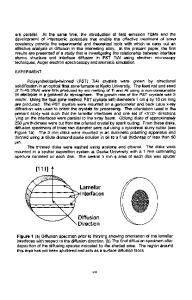Effect of deformation temperature on fatigue and fracture behavior in TiAl polysynthetically twinned crystals
- PDF / 1,334,497 Bytes
- 8 Pages / 612 x 792 pts (letter) Page_size
- 31 Downloads / 429 Views
INTRODUCTION
SINCE the discovery of a good combination of high strength and good ductility in two-phase Ti-rich TiAl alloys, a great deal of attention has been paid to gamma TiAl as a potentially attractive material to satisfy the strong demand from the aerospace and automobile industries for new lightweight, heat-resistant materials. Significant progress has recently been made in improving the mechanical properties of the gamma TiAl alloys through alloy development, processing, and microstructure control.[1–5] Structural applications of these alloys require knowledge not only of monotonic deformation but also of plastic behavior under cyclic loading conditions. A unique deformation substructure is known to form during the to-and-fro motion of dislocations under cyclic loading. A fundamental understanding of the deformation substructure and fatigue behavior in metals has been obtained from the work conducted on single crystals of fcc metals.[6,7] For example, veins, persistent slip bands (PSBs), and labyrinth and wall structures were all formed in Cu single crystals during fatigue loading, depending on the stress and/or strain amplitudes.[7] The PSBs were accompanied by parallel arrays of edge dislocation ladders or walls. These bands often produced heavy extrusion/ intrusion steps on the specimen surface, which caused crack initiation leading to failure. In intermetallics of Ni3Al single crystals, FeCo-V polycrystals, and TiAl polycrystals, a large number of dislocation dipoles and loops were observed instead of ladder structures.[8,9,10] Several investigaY. UMAKOSHI, Professor, H.Y. YASUDA and T. NAKANO, Research Associates, and K. IKEDA, Graduate Student, are with the Department of Materials Science and Engineering, Faculty of Engineering, Osaka University, Osaka 565-0871, Japan. This article is based on a presentation made in the symposium ‘‘Fundamentals of Gamma Titanium Aluminides,’’ presented at the TMS Annual Meeting, February 10–12, 1997, Orlando, Florida, under the auspices of the ASM/MSD Flow & Fracture and Phase Transformations Committees. METALLURGICAL AND MATERIALS TRANSACTIONS A
tions of fatigue deformation and fracture behavior showed that polycrystalline TiAl alloys have exceptionally high ratios of fatigue strength to ultimate tensile strength in fully lamellar microstructured conditions.[11–19] TiAl polysynthetically twinned (PST) crystals have been used to obtain fundamental information on the effect of the lamellar structure on plastic deformation and fracture behavior.[20–28] Recent investigations of the effects of loading axis and lamellar structure on cyclic deformation in TiAl PST crystals found strong anisotropy in cyclic hardening, deformation substructure, and fatigue life.[13–19] In monotonic loading conditions, plastic behavior such as operative slip and twinning systems, ductility, and yield stress depended strongly on deformation temperature.[20–25] In cyclic loading conditions, polycrystalline TiAl alloys also show a strong dependence of deformation and fracture behavior on micros
Data Loading...











